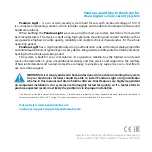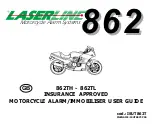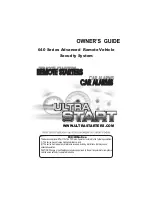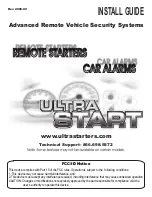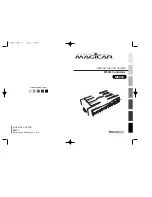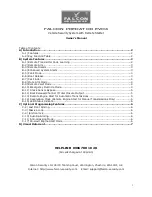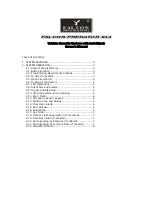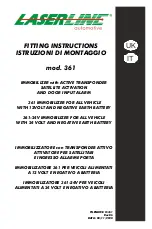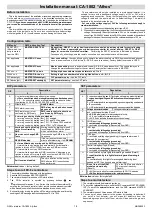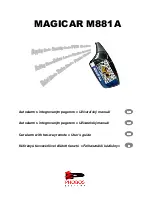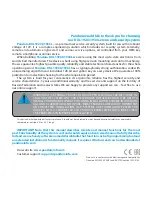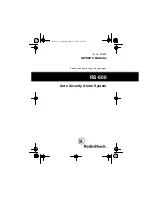addition to requiring the ignition key, one to two separate stages of pressing the Valet
Switch may also be custom programmed as a requirement to accomplish the
disarming of the system. Each of these stages may be further customized by
programming multiple presses of the valet switch. This programmable feature, which
is explained in detail on pages 29-30), allows you to further enhance the effectiveness
of your security system by "hardening" its resistance to being defeated. The factory-
set default for Selectable Code Override is one press at stage 1, and NO press at stage
2; this is the most convenient and user-friendly setting. Therefore, the following step-
by-step instructions reflects first the default setting, and then the following text
continues to explain the custom-programmed setting:
Step 1 - While the system in the armed condition, enter via the driver's door. Be
aware that the system will activate when the door is opened, sounding the horn,
flashing the parking and dome lights, and locking the doors if the door entered is
closed again before disarming the system.
Step 2 - Using your key, turn the ignition "on". The following step must be
performed within the next 10 seconds.
Step 3 - Momentarily press the valet switch equal to the number programmed for
stage #1; the factory setting is one.
If the factory default setting of 1 and 0 presses
is retained, the system will disarm. The disarming will be accompanied by four
horn chirps.
Page - 13
If the valet switch is pressed an incorrect number of times, or if stage #2 presses
have been programmed, the system will not disarm, but pause and chirp the horn
before continuing to sound. When a stage #2 entry is required, at this point the stage
#2 entry must be made within 10 seconds. After a failed attempt to achieve Selectable
Code Override, the ignition switch must be turned "off", then "on" again before another
attempt is made. If two failed Selectable Code Override attempts are made, the
system will ignore any further presses of the valet switch for two minutes. If this
occurs, the system will reset to the armed state, then sound the horn twice after 2
minutes to indicate that another attempt may be made to achieve Selectable Code
Override. See pages 29-30 for further explanation of the Selectable Code Override.
Once the system is disarmed, if Valet Mode is desired, use the Easy Valet
TM
procedure to place the system into Valet Mode. Remember, if the Selectable Code
Override factory setting of "stage 1, one valet switch press and stage 2, no valet switch
press" is still present, simply pressing the valet switch once within 10 seconds of
turning the ignition switch "on" will override and disarm the system.
Your Model One system includes a Remote Panic feature. In the event of attack
or assault, or any time you feel threatened or in need of assistance, you can use your
remote transmitter to activate this feature. This feature operates regardless of the
system's status, or if the ignition switch is "on" or "off".
Remote Panic
Page - 14
Pressing and holding the PANIC button for 2 seconds will activate this feature,
sounding the horn, flashing the parking lights for 60 seconds, and locking the doors.
After 60 seconds, the system will stop and reset. The car's doors will remain
locked, and the system will remain in the armed condition. If the system was in Valet
Mode when Remote Panic was engaged, the system will be in an armed state if panic
is stopped or if it is allowed to reset at 60 seconds. If you wish to stop the Panic feature
during the 60 second period, press either the PANIC, LOCK or UNLOCK button.
When doing this, pressing PANIC leaves the system armed without a door lock
operation; pressing LOCK to stop panic will leave the system armed with locked doors,
and pressing UNLOCK will leave the system disarmed with unlocked doors. If desired,
the PANIC button may be used to operate the Additional Output; this programmable
feature is described on page 39.
There are 12 distinct indications that the LED Status Light can show in normal daily
use; these are categorized into three areas: Security System Status, Automatic
Transmitter Verification
TM
, and Zone Violation.
System Status: The LED status light is a visual indicator of what state the security
system is in at any given time. It is normally positioned in a location that is easily
observed by the driver. There are 4 possible status conditions that the system can
be in, and are reflected by the LED status light:
The LED Status Light
Page - 15
-
Off
= The system is disarmed and not performing any automatic
functions.
-
On Constant
= The system is in the Valet Mode.
-
Flashing Slow
= The system is fully armed.
-
Flashing Fast
= The Last Door Arming or Automatic Rearming features are in
progress. This indication also occurs during the 3 second
arming delay (a 45 second arming delay is optional).
Automatic Transmitter Verification
TM
: After the ignition is turned "on", the LED
status light will flash to indicate the number of transmitters programmed to operate the
system. For example: two flashes and a pause indicates that only two transmitters
are programmed to operate the system. This display is shown for 10
seconds every time the ignition switch is turned "on". More importantly, for 48 hours
after any transmitter programming has occurred, the horn will chirp for two seconds
and the LED status light will flash for 90 seconds. This warning protects against
unauthorized transmitters from being added to your system.
Zone Violation: If the system is activated, the LED status light will start to flash
and pause the following coded sequences to indicate which protected circuit caused
the activation. This will be seen at all times, until the ignition switch is turned "on",
which will clears the system's memory. The unit's memory can store four different
codes, and if multiple violations involving different zones occurred, the different
Page - 16


